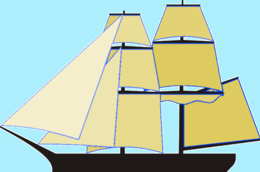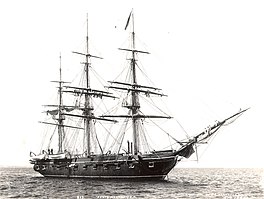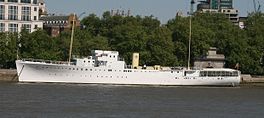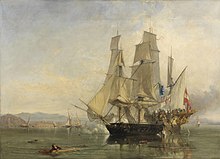|
Sloop-of-war During the 18th and 19th centuries, a sloop-of-war was a warship of the British Royal Navy with a single gun deck that carried up to 18 guns. The rating system of the Royal Navy covered all vessels with 20 or more guns; thus, the term encompassed all unrated warships, including gun-brigs and cutters. In technical terms, even the more specialised bomb vessels and fire ships were classed by the Royal Navy as sloops-of-war, and in practice these were employed in the role of a sloop-of-war when not carrying out their specialised functions. In World War I and World War II, the Royal Navy reused the term "sloop" for specialised convoy-defence vessels, including the Flower class of the First World War and the highly successful Black Swan class of the Second World War, with anti-aircraft and anti-submarine capabilities. They performed similar duties to the destroyer escorts of the United States Navy, and also performed similar duties to the smaller corvettes of the Royal Navy. RiggingA sloop-of-war was quite different from a civilian or mercantile sloop, which was a general term for a single-masted vessel rigged in a way that would today be called a gaff cutter (but usually without the square topsails then carried by cutter-rigged vessels), though some sloops of that type did serve in the 18th century British Royal Navy, particularly on the Great Lakes of North America. In the first half of the 18th century, most naval sloops were two-masted vessels, usually carrying a ketch or a snow rig. A ketch had main and mizzen masts but no foremast. A snow had a foremast and a main mast immediately abaft which a small subsidiary mast was fastened on which the spanker was set.[1] Ship sloopThe first three-masted, i.e., "ship rigged", sloops appeared during the 1740s, and from the mid-1750s most new sloops were built with a three-masted (ship) rig. The third mast afforded the sloop greater mobility and the ability to back sail. Brig sloop In the 1770s, the two-masted sloop re-appeared in a new guise as the brig sloop, the successor to the former snow sloops. Brig sloops had two masts, while ship sloops continued to have three (since a brig is a two-masted, square-rigged vessel, and a ship is a square-rigger with three or more masts, though never more than three in that period). In the Napoleonic period, Britain built huge numbers of brig sloops of the Cruizer class (18 guns) and the Cherokee class (10 guns). The brig rig was economical of manpower – important given Britain's chronic shortfall in trained seamen relative to the demands of the wartime fleet. When armed with carronades (32-pounders in the Cruizer class, 18-pounders in the Cherokee class), they had the highest ratio of firepower to tonnage of any ships in the Royal Navy, albeit within the short range of the carronade. The carronades also used much less manpower than the long guns normally used to arm frigates. Consequently, the Cruizer class were often used as cheaper and more economical substitutes for frigates, in situations where the frigates' high cruising endurance was not essential. A carronade-armed brig, however, would be at the mercy of a frigate armed with long guns, so long as the frigate maneuvered to exploit its superiority of range. The other limitation of brig sloops as opposed to post ships and frigates was their relatively restricted stowage for water and provisions, which made them less suitable for long-range cruising. However, their shallower draught made them excellent raiders against coastal shipping and shore installations. Bermuda sloop The Royal Navy also made extensive use of the Bermuda sloop, both as a cruiser against French privateers, slavers, and smugglers, and also as its standard advice vessels, carrying communications, vital persons and materials, and performing reconnaissance duties for the fleets. Bermuda sloops were found with gaff rig, mixtures of gaff and square rig, or a Bermuda rig. They were built with up to three masts. The single masted ships had huge sails and harnessed tremendous wind energy, which made them demanding to sail and required large, experienced crews. The Royal Navy favoured multi-masted versions, as it was perennially short of sailors at the end of the 18th century, and its personnel received insufficient training (particularly in the Western Atlantic, priority being given to the continuing wars with France for control of Europe). The longer decks of the multi-masted vessels also had the advantage of allowing more guns to be carried. ClassificationOriginally a sloop-of-war was smaller than a sailing frigate and was (by virtue of having too few guns) outside the rating system. In general, a sloop-of-war would be under the command of a master and commander rather than a post captain, although in day-to-day use at sea the commanding officer of any naval vessels would be addressed as "captain". A ship sloop was generally the equivalent of the smaller corvette of the French Navy (although the French term also covered ships up to 24 guns, which were classed as post ships within the sixth rate of the British Navy). The name corvette was subsequently also applied to British vessels, but not until the 1830s. American usage, while similar to British terminology into the beginning of the 19th century, gradually diverged. By about 1825 the United States Navy used "sloop-of-war" to designate a flush-deck ship-rigged warship with all armament on the gun deck; these could be rated as high as 26 guns and thus overlapped "third-class frigates," the equivalent of British post-ships. The Americans also occasionally used the French term corvette.[2] History In the Royal Navy, the sloop evolved into an unrated vessel with a single gun deck and three masts, two square rigged and the aft-most fore-and-aft rigged (corvettes had three masts, all of which were square-rigged). Steam sloops had a transverse division of their lateral coal bunkers[3] in order that the lower division could be emptied first, to maintain a level of protection afforded by the coal in the upper bunker division along the waterline. During the War of 1812 sloops of war in the service of the United States Navy performed well against their Royal Navy equivalents. The American ships had the advantage of being ship-rigged rather than brig-rigged, a distinction that increased their manoeuvrability. They were also larger and better armed. Cruizer-class brig-sloops in particular were vulnerable in one-on-one engagements with American sloops-of-war.[4] DeclineIn the second half of the 19th century, successive generations of naval guns became larger and with the advent of steam-powered sloops, both paddle and screw, by the 1880s even the most powerful warships had fewer than a dozen large calibre guns, and were therefore technically sloops. Since the rating system was no longer a reliable indicator of a ship's combat power, it was abolished altogether and with it the classifications of sloops, corvettes and frigates. Instead a classification based on the intended role of the ship became common, such as cruiser and battleship. RevivalDuring the First World War, the sloop rating was revived by the British Royal Navy for small warships not intended for fleet deployments. Examples include the Flower classes of "convoy sloops", those designed for convoy escort, and the Hunt class of "minesweeping sloops", those intended for minesweeping duty. The Royal Navy continued to build vessels rated as sloops during the interwar years. These sloops were small warships intended for colonial "gunboat diplomacy" deployments, surveying duties, and acting during wartime as convoy escorts. As they were not intended to deploy with the fleet, sloops had a maximum speed of less than 20 knots (37 km/h). A number of such sloops, for example the Grimsby and Kingfisher classes, were built in the interwar years. Fleet minesweepers such as the Algerine class were rated as "minesweeping sloops". The Royal Navy officially dropped the term "sloop" in 1937, although the term remained in widespread and general use.  World War IIDuring World War II, 37 ships of the Black Swan class were built for convoy escort duties. However, the warship-standards construction, propulsion and sophisticated armaments of the sloop of that time shared bottlenecks with destroyers and did not lend themselves to mass production on commercial shipyards, thus the sloop was supplanted by the corvette, and later the frigate, as the primary escort vessel of the Royal Navy. Built to mercantile standards and with (initially) simple armaments, these vessels, notably the Flower and River classes, were produced in large numbers for the Battle of the Atlantic. In 1948 the Royal Navy reclassified its remaining sloops and corvettes as frigates, even though the term sloop had been officially defunct for nine years. 2010sThe Royal Navy has proposed a concept, known as the "Future Black Swan-class Sloop-of-war",[5] as an alternative to the Global Corvette of the Global Combat Ship programme. Notable sloops


See also
ReferencesNotes
Bibliography
External linksWikimedia Commons has media related to Sloop-of-war.
|
